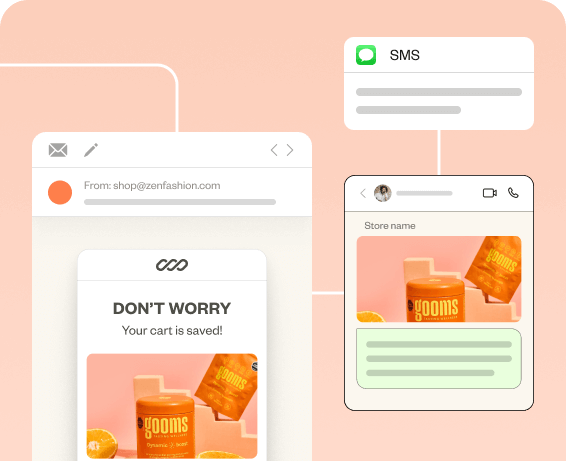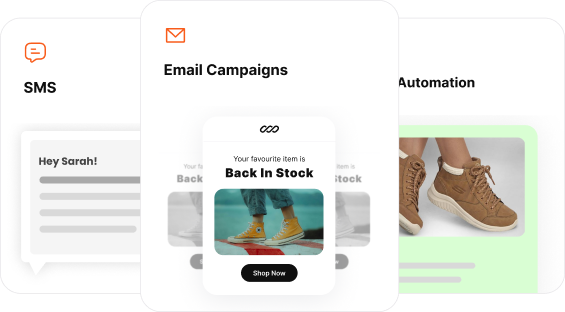An estimated 14% of packages faced shipping delays or were missed during Black Friday. For merchants, these shipping delay Black Friday issues don’t just lead to customer complaints; they directly translate into lost revenue from cancellations.
Moreover, delayed shipping brings in negative reviews and damaged brand loyalty.
The core pain point is simple: how can you secure reliable shipping and keep your promises when carriers are overwhelmed?
In this article, we’ve shared
- Top reasons for shipping delays during Black Friday and their impact on your business
- 6 Proven strategies to reduce Black Friday shipping delays
- How to communicate with your customers during shipping
- 3 Must-have apps for tracking orders in real-time
- Examples of how big brands are handling shipping delays
Create personalized omnichannel campaigns that your customers love effortlessly with Retainful’s cross-channel automation workflows.
Why do shipping delays happen on Black Friday?
Here are the 7 most common reasons for shipping delays on Black Friday
- High order volume: Millions of orders flood carriers at once, causing bottlenecks.
- Carrier capacity limits: UPS, FedEx, USPS, and others struggle to handle peak demand.
- Labor shortages: Limited warehouse staff and drivers slow down processing and delivery.
- Warehouse strain: Fulfillment centers face backlogs when processing thousands of orders daily.
- Supply chain disruptions: Global shortages, customs delays, and port congestion add extra delays.
- Weather conditions: Winter storms and bad weather can ground planes and delay trucks.
- Incorrect shipping details: Customer errors in addresses or information cause reroutes and extra time.
Related Reading: E-commerce SMS Marketing Guide: Setup, Strategy & Templates.
Impact of Black Friday shipping delays on your business
Shipping delays during Black Friday don’t just frustrate customers; they directly affect your revenue, brand image, and long-term growth.
Let’s break down the key consequences:
- Increased refunds & cancellations: When orders arrive late, customers are more likely to cancel purchases or demand refunds, which eats into your holiday profits.
- Negative customer reviews & loss of trust: Slow shipping often leads to negative reviews on social media and marketplaces, damaging your credibility and deterring future buyers.
- Damaged brand loyalty: Black Friday is an emotional buying period. If shoppers face delivery delays, they may switch to competitors and never return.
- Hidden costs (support tickets, reshipments, chargebacks): Delays create extra workload for your support team. Handling complaints, reshipping orders, and managing chargebacks all add hidden operational costs.
Related reading: 10 Best Product Review Request Email Examples + Free Templates.
Create omnichannel workflows effortlessly with Retainful’s pre-built automation and segmentation templates.
6 Proven strategies to reduce shipping delays during Black Friday
The core challenge of Black Friday logistics is simple: peak volume overwhelming fixed carrier and warehouse capacity. The winning strategy is to spread out the volume, lock in resources early, and reduce fulfillment errors.
Here are 6 proven strategies to reduce shipping delays during Black Friday:
- Forecast and prepare for Black Friday season
- Partnering with multiple carriers / 3PLs
- Encourage placing early orders
- Reduce mistakes in customer information
- Offer alternatives for out-of-stock products
- Provide pick-up options
1. Forecast and prepare for Black Friday season
Shipping delays begin with an inaccurate sales forecast. You cannot secure the right labor, inventory, or shipping capacity if you are caught off guard.
- Forecast and plan: Don’t just forecast a total sales lift; use last year’s data to predict exactly which will be your top sellers and in what quantity. This prevents overselling high-demand products and having overstock on slow-movers.
- Secure inventory and packaging early: Order inventory 8-12 weeks in advance, accounting for supplier lead times. Critically, pre-order all essential shipping supplies. For example, boxes, tape, bubble wrap, and custom inserts to avoid last-minute price gouging or shortages.
- Stress-Test Your Warehouse Management System: Ensure your tech stack is seamlessly integrated. Run a test by manually entering a high volume of ‘ghost orders’ to ensure the system can handle the expected throughput without crashing or mislabeling.
2. Partnering with multiple carriers / 3PLs
Reliance on a single carrier is the fastest path to a disaster during peak season. When their network hits capacity, your parcels stop moving.
- Adopt a multi-carrier strategy: Establish relationships with at least two national carriers (e.g., FedEx and UPS) and one or two reputable regional carriers. This diversification allows you to instantly shift volume away from a carrier experiencing bottlenecks or unexpected service interruptions.
- Lock in carrier capacity: Major carriers impose volume caps during BFCM. Negotiate and commit to your estimated volumes with each carrier well in advance (often by late summer or early fall) to guarantee space in their network.
- Leverage a 3PL (Third-Party Logistics) Partner: A 3PL provides flexible labor and warehouse space that is already optimized for high volume. They absorb the risk and cost of scaling up. A good 3PL with multiple fulfillment centers can also position your inventory closer to major customer hubs, shortening the Last Mile delivery time.
3. Encourage placing early orders
Your goal is to smooth out the typical one-week peak into a 3-4 week ‘extended peak’ to prevent an unmanageable spike in volume.
- Use tiered incentives: Announce that shipping cutoffs will be non-negotiable for Christmas delivery, creating urgency for early shopping. Offer a better discount or gift-with-purchase for orders placed in the first week of November compared to the Black Friday weekend itself.
- Launch a VIP/Early access sale: Offer your loyal customers or email subscribers exclusive access to Black Friday deals one week early. This rewards loyalty and allows you to process a significant chunk of orders before the general public rush begins.
Here is an example email for launching an early access sale

Related reading: 10 Best Discount Email Templates + Examples.
4. Reduce mistakes in customer information
A small error in an address, product, or quantity can halt an order, leading to manual correction, delays, and a potential reshipment.
- Implement address validation software: Use a tool at checkout that verifies a customer’s address against postal databases in real-time. This prevents shipments from being lost or returned due to simple typos or incorrect ZIP codes.
- Barcode scanning for picking & packing: Equip your warehouse team with barcode scanners. Scanning the product and the order slip ensures the correct item is picked and packed, drastically reducing picking errors that lead to costly and time-consuming reshipments.
Related reading: 7 Best Double Opt-in Email Examples + Best Practices.
5. Offer alternatives for out-of-stock products
A product running out of stock forces a customer to leave. As a result in a sale will be lost. You can capture that revenue and smooth demand for similar items.
- Recommend a substitute: If an item is out of stock, immediately show 2-3 highly relevant, in-stock alternatives. Use clear messaging: “Sold Out, but we recommend the [Substitute Product Name] – In Stock and Ready to Ship!”
- Pre-orders and waitlists: If the item is expected to be restocked soon, allow customers to pre-order or sign up for a priority waitlist. This captures the sale, provides you with crucial demand data, and manages the customer’s expectation by communicating an estimated ship date before they check out.
Related reading: 10 Best Back in Stock Email Examples (Tips + Free Templates).
6. Provide pick-up options
For local customers or those living near your store/warehouse, offering a pickup option bypasses carrier networks entirely, guaranteeing the customer gets their order instantly.
- Offer buy online, pick up in store: For retailers with physical locations, set up a simple, safe in-store or curbside pickup service. Promote this option heavily with messaging like: “Beat the Shipping Delays: Pick Up FREE Today!”
- Incentivize local pickup: Offer a small bonus (e.g., a $5 coupon for a future purchase or a free small item) to customers who choose the pickup option. This shifts volume away from the delivery network and reduces your final-mile shipping costs.
Related Reading: How to Send Automatic Text Messages in 2025 (3 Types + Free Templates).
4 Best Practices to manage customer expectations during shipping delays
When Black Friday volume inevitably causes shipping delays, the key to protecting your brand loyalty is transparency. Proactive and honest communication transforms a negative logistical issue into a positive customer service experience.
Here are 4 best practices to manage customer expectations during shipping delays:
- Transparent communication through multiple channels
- Provide real-time tracking
- Proactive customer support (Email & SMS alerts)
- Keeping website shipping estimates realistic
Related reading: Black Friday Sales: Deal Ideas, Trends & Strategies.
1. Transparent communication through multiple channels
Never wait for the customer to ask “Where Is My Order?” (WISMO). Be the first to tell them about delays, even if it’s just a possibility.
- Website banners & pop-ups: Place clear, non-intrusive banners/pop-ups on your homepage, cart, and checkout page about shipping expectations. For example, “Due to holiday peak volume, expect an extra 3-5 business days for fulfillment and shipping.” This sets the expectation from the start.
- Shipping policy updates: Update your official shipping policy page to reflect current peak season delivery windows, not your standard year-round times.
- Order confirmation emails: Reiterate the potential for delays in the order confirmation email. Use a dedicated paragraph to explain the situation and link directly to your shipping policy and tracking page.
Related reading: 5 Real-life Omnichannel marketing examples (Detailed case study).
2. Provide real-time tracking
Customer anxiety spikes when a package seems to disappear after it leaves the warehouse. Real-time tracking is the single most effective tool for self-service and reducing support inquiries.
- Branded tracking pages: Use a tracking service that provides a branded tracking page. This keeps the customer on your website, reinforces your brand, and prevents them from seeing only generic carrier error messages.
- Visibility at every step: The tracking page should show clear status updates: Order Received, Processing, Shipped, In Transit, Out for Delivery, etc. This continuous flow of information minimizes panic.
3. Proactive customer support (Email & SMS alerts)
Automate communication for specific events so customers are informed the moment a problem arises.
- Delay triggers: Set up automated alerts that trigger an email or SMS notification if a tracking status hasn’t updated for more than 48-72 hours.
- In-Transit updates: Use SMS to notify customers when their package is out for Delivery or has just been delivered.
Engage customers and retain them effortlessly with Retainful’s pre-built automation workflows.
4. Keeping website shipping estimates realistic
The most damaging thing you can do is promise 2-day delivery and deliver in 10. Honesty about delivery times is more important than speed during the holidays.
- Review your data: Analyze last year’s BFCM carrier performance data to calculate true average delivery times.
- Adjust checkout estimates: Update your checkout page to display the conservative, actual delivery estimate. If your carrier normally takes 3 days but takes 7 during BFCM, advertise 7-10 Business Days for that shipping method.
Related Reading: 11 Best SMS Marketing Strategies for 2025.
Top 3 shipping apps for delivering your orders on time during BFCM
We’ve explored multiple shipping software to find the 3 best apps to beat Black Friday shipping delays.
| Application | Free plan | Lowest Price | Best feature |
| Parcel Panel | ✅ | $11/month | Branded multi-lingual order tracking page |
| TrackingMore | ✅ | $9/month | Multi-carrier shipment tracking platform |
| Parcelous.com | ✅ | $9.99/month | Order tracking software with dropshipping features |
1. Parcel Panel – Order tracking software
Parcel Panel primarily focused on order tracking to enhance customer satisfaction.
It reduces support tickets (WISMO) and simultaneously drives sales by using the tracking experience as a marketing opportunity.
Shopify rating: 5.0 out of 5.0
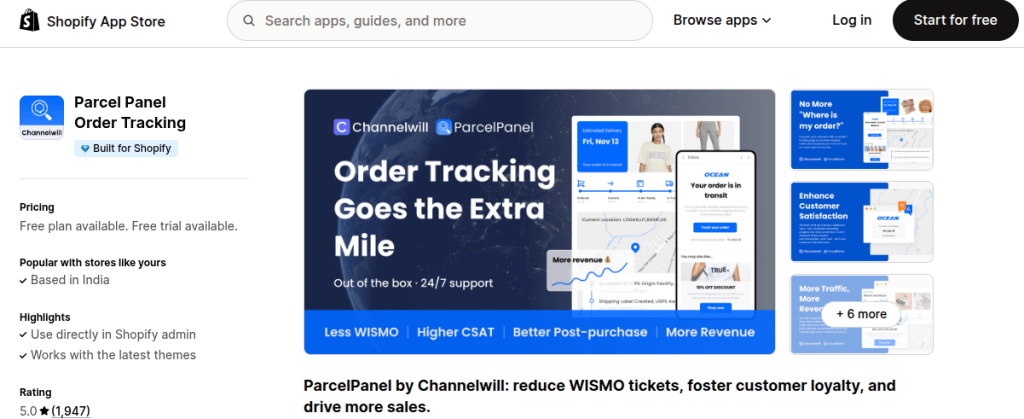
Key features:
- Real-time tracking & exception resolution: Tracks orders in real-time, allowing merchants to resolve delivery issues or exceptions before the customer complains.
- Branded & multilingual tracking page: Provides a custom-branded order lookup page with rich customization options and support for multiple languages, effectively eliminating “Where is my order?” inquiries.
- Proactive shipping notifications: Automatically sends timely email and SMS alerts to customers upon order status updates (e.g., in transit, delivered, etc).
- Sales generation tools: Features a smart upsell system to promote products and drive more sales directly from the tracking page.
- Shipping & analytics: Offers analytics to optimize shipping solutions and includes functionality to sync tracking information to platforms like PayPal.
- 24/7 Support: Provides round-the-clock customer support via live chat or email.
Parcel Panel pricing:
- Free plan: Free, 20 orders/month
- Essential plan: $11 / month (or $108/year), 200 orders/month
- Professional plan: $59 / month (or $564/year), 2,000 orders/month
- Enterprise plan: $479 / month (or $4,548/year), 25,000 orders/month
Related reading: What is Email Marketing? – An Ultimate Beginner’s Guide.
2. TrackingMore shipment tracking platform
TrackingMore is a multi-carrier shipment tracking platform designed for e-commerce, offering real-time visibility and reducing support queries.
Shopify rating: 4.9 out of 5.0
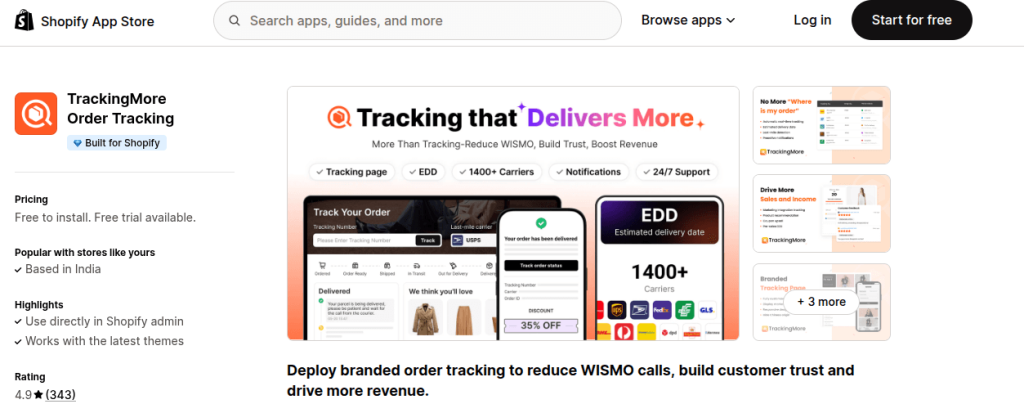
Key features:
- Branded tracking pages: Customizable, multilingual tracking pages with Estimated Delivery Dates (EDD) to enhance customer trust and eliminate WISMO calls.
- Proactive notifications: Automates smart email notifications to boost customer engagement and keep them informed of order status updates.
- Sales & conversion tools: Increases revenue with an intelligent upsell system and discount promotions, plus pre-sales EDD to boost conversion rates.
- Dropshipping support: Features a one-click dropshipping mode to hide Chinese origin details for brand protection.
- Logistics management: Includes real-time last-mile detection and automatic synchronization of shipping information with PayPal.
- Integrations: Works with major platforms and apps, including Customer Accounts, Shopify Flow, PayPal, Slack, and more.
TrackingMore pricing:
- Free plan: Free to install, 50 shipments per month
- Basic plan: $9 / month (or $90/year), 200 orders per month
- Pro plan: $55 / month (or $550/year), 2,000 orders per month
- Enterprise plan: $1,189 / month (or $11,890/year), 70,000 orders per month
Related reading: How to make money with Email Marketing (10 Proven Ways).
3. Parcelous – Order tracking software with dropshipping features
Parcelous enables merchants to turn their tracking page into a revenue channel using product upsells, real-time updates, and dropshipping features.
Shopify rating: 5.0 out of 5.0
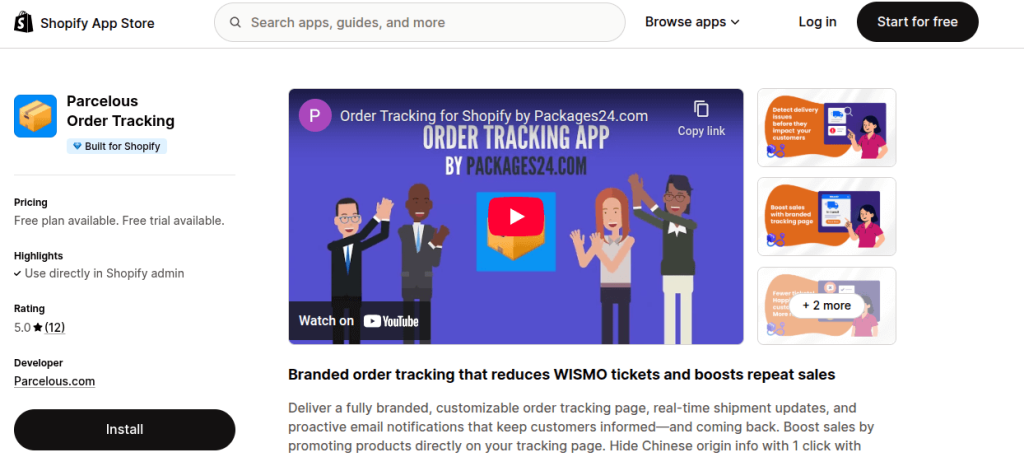
Key features:
- Branded experience: Deliver a fully branded, customizable, and multilingual order tracking page.
- WISMO reduction: Shows Estimated Delivery Dates (EDD) and provides proactive email notifications to reduce “Where Is My Order?” tickets.
- Revenue booster: Turn the tracking page into a sales channel with product upselling features.
- Dropshipping ready: Hide Chinese origin and carrier information with a single click to protect your brand.
- Automation: Tracks orders automatically with smart carrier detection (hundreds supported) and automatic tracking features.
Parcelous pricing:
- Free plan: Free, 50 orders per month
- Basic 300 plan: $9.99 / month (or $99.99/year), 300 orders per month
- Advanced 1500 plan: $29.99 / month (or $299.99/year), 1,500 orders per month
- Advanced 3000 plan: $49.99 / month (or $499.99/year), 3,000 orders per month
Related reading: Email Automation: An Ultimate Guide for Beginners 2025.
Examples of brands handling shipping delays
We’ve shared some examples to show you how brands are handling shipping delays.
- Threads email update regarding shipment delay
- Jiomart email and SMS alerts regarding shipment updates
1. Threads – Shipment delay email example
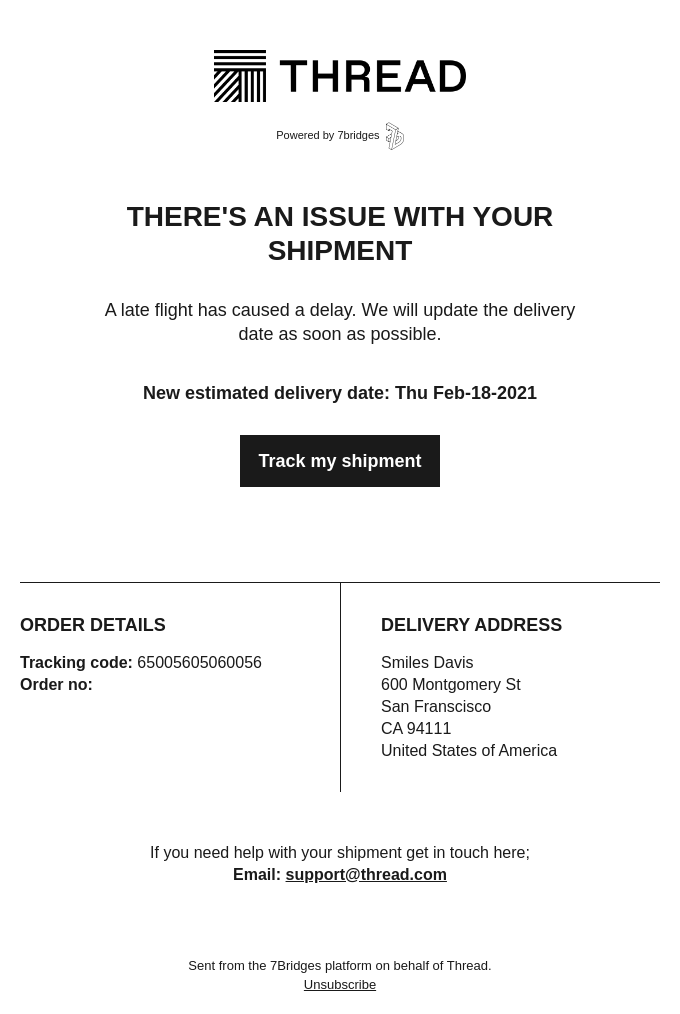
Key takeaways:
- Transparent reason for delay: The email provides a specific, albeit brief, reason for the delay: “A late flight has caused a delay”.
- Immediate new estimated delivery date (EDD): The email manages customer expectations by immediately providing a new EDD: Thu Feb-18-2021.
- Encouraging self-service: A prominent “Track my shipment” button is included, which directs the customer to a self-service page to check the status, reducing direct support inquiries.
- Clear support channel: A dedicated support email address ([email protected]) is provided for customers needing help with their shipment.
2. Jiomart shipment delay email and SMS alert
Shipment delay email example
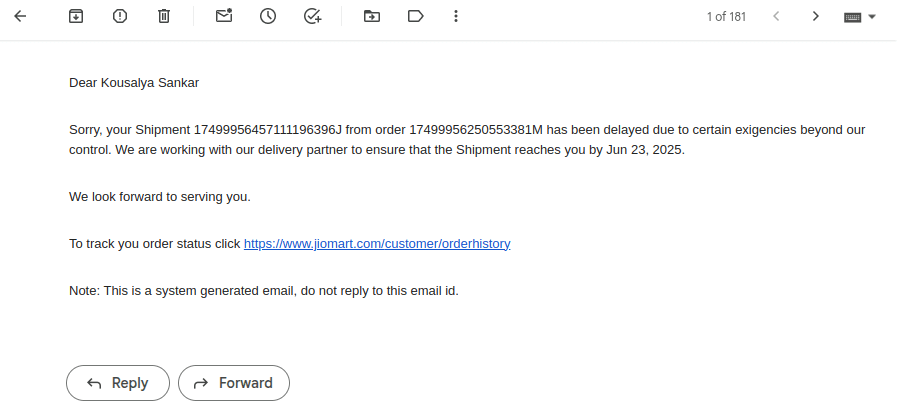
Key takeaways:
- Proactive delay communication: The company proactively notified the customer via email that their shipment was delayed.
- Managing expectations with a new EDD: They attempted to ease frustration by updating and setting a new Estimated Delivery Date (EDD).
- Providing a self-service tracking link: The email includes a direct link for the customer to track their order status, encouraging self-service and reducing WISMO calls.
Shipment update via SMS
This is a standard SMS notification from JioMart informing the recipient that a recent delivery attempt failed. It confirms the shipment tracking number and promises a quick re-attempt.

Key takeaways:
- Clear attribution and order reference: The message immediately names the sender and includes the full shipment number, allowing the customer to cross-reference.
- Sets a proactive next step: It manages expectations by immediately informing the customer that the company will “try again to deliver your package soon”.
Join 20,000+ eCommerce stores already using Retainful to grow with Omnichannel marketing.
Wrap up!
With 23% of online shoppers refusing to repurchase after a single delayed delivery, one late package can cost you more than just a sale; it can cost you long-term loyalty.
This Black Friday, don’t let shipping delays hold your business back. The goal isn’t just to deliver faster, it’s to deliver reliability, transparency, and trust when it matters most.
Use the 6 proven strategies shared in this guide and leverage shipping apps like TrackingMore, Parcel Panel, and Parcelous to stay ahead of the rush.
Every minute saved in shipping is a step closer to better reviews, happier customers, and higher repeat orders.
Also read:
- 10 Free Black Friday Email Templates (Examples + Tips)
- Shopify Black Friday success guide: Top apps and strategies for 2025
- 120+ Black Friday email subject lines for 2025 (with AI prompts)
Frequently asked questions
Yes, shipping is slower during Black Friday because carriers face overwhelming order volumes, labor shortages, and seasonal delays.
Delays typically last 2–7 days for domestic orders and longer for international shipments.
High order volume, carrier capacity limits, labor shortages, supply chain issues, and weather disruptions all contribute to Black Friday shipping delays.
Stores can reduce delays by forecasting demand, setting shipping cut-off dates, using multiple carriers, and encouraging early orders.
Respond quickly, share tracking updates, and offer goodwill gestures like coupons or loyalty points to maintain trust.
